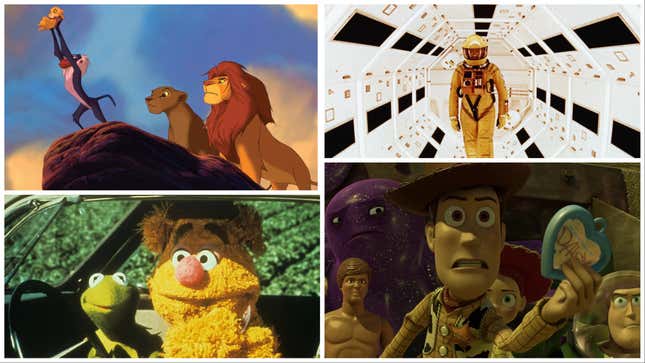
It’s hard to imagine a world without G-rated movies, but we’re getting there. Since the rating system was instituted in 1968, beloved films like Willy Wonka & The Chocolate Factory, Babe, The Muppet Movie, Chicken Run, 2001: A Space Odyssey, The Lion King, Star Trek: The Motion Picture, and even Planet Of The Apes, along with plenty of animated features, have all carried G ratings.
Over the past two decades, however, the PG rating has increasingly gained favor among studios, filmmakers, and audiences, in part because longtime G-ratings powerhouse Disney and Pixar shifted their emphasis to PG films, starting with The Incredibles in 2004. Most of their subsequent films, including Coco, Soul, and Elemental, have carried a PG rating.
Writer/director Lee Unkrich spent 25 years at Pixar, where he co-directed Toy Story 2 and Finding Nemo, and directed Toy Story 3 and Coco. During a recent Zoom call he explained that, for a long time, Pixar felt beholden to an “expectation” that the company’s movies needed to be rated G. “We wanted them to be for everybody, from the littlest kids to great-grandparents,” Unkrich said, “and that’s what we did for many, many films.”
An Incredibles change at Pixar
Everything changed when Brad Bird pitched The Incredibles. “John loved it and wanted Brad to be at the studio,” Unkrich said, referring to longtime Pixar boss John Lasseter. “So, we made The Incredibles. But I think all of us understood from day one that that was not going to be a G-rated film, because it was going to have so much intense action and explosions, and the kinds of things we hadn’t had in a Pixar film up to that point. Everyone just held hands and said, ‘Alright, we’re gonna have the first PG-rated Pixar film.’ Of course, it was huge and popular, and it didn’t seem to matter that it wasn’t rated G.
How did the G rating fall so out of vogue that, as Unkrich notes, “it didn’t seem to matter” to even Pixar that their films would carry a PG? The reasons are plentiful, according to Paul Dergarabedian, senior media analyst at Comscore, including a societal shift in thinking about what’s appropriate for small children, and the idea that G-rated films are burdened with the stigma of being uncool for teens and young adults. “Over time, as people became more accustomed to edgier fare, audiences wanted a little more edge to their movies,” he said. “And G became a tougher sell. Shrek was a turning point. Parents thought, ‘Wow, will this be OK for my kids? It’s PG.’ It’s so ironic that a slightly more restrictive rating, the PG versus G, in the modern era, opened those films up to a broader audience.”
It’s worth noting, however, that G movies still make big bucks. Pixar’s Toy Story 4, for instance, grossed $1 billion worldwide in 2019, while Paramount/Nickelodeon’s PAW Patrol: The Movie, which cost a relatively inexpensive $26 million to make, grossed $144 million worldwide in 2021. Still, PG seems like the safer bet for most titles, because it allows family films to go a bit darker and even drop in sly, wink-wink references for teens and adults.
Toy Story 3 incinerates the G-rating
But old habits die hard, especially in animated films. For Unkrich, “even after The Incredibles, there still was this unspoken [thought that], ‘We really want the movies to be rated G.’” The Toy Story 2 co-director, whose current project is an epic 2,200-page book about a memorable R-rated movie, called Stanley Kubrick’s The Shining, continues: “In fact, I remember when I was making Toy Story 3, when we were finishing it up, I was 1,000 percent convinced that it was going to get a PG.”
How could it not with the infamous incinerator scene?
“I know! I know,” Unkrich acknowledged. “I remember there being conversations within the studio and with Disney just to prepare everyone that it was likely going to get a PG because of the intensity at the end of the film. At that point, a Disney executive who I’d rather not name, said, ‘Well, PG is the new G.’ That was a phrase I subsequently heard a lot. There was a point of transition where people just accepted that PG (replaced G). I don’t think parents, except maybe (those with) little kids, looked at a PG rating and gave it a second thought. I think they just thought, ‘If it’s not R, then it’s OK for my kids.”
G is the “light beer of ratings”
Bringing the G-rating saga full circle means boldly going to Robert Wise’s Star Trek: The Motion Picture. In 1979, the much-maligned first big-screen adventure of the Enterprise crew received a G despite a decent amount of violence and some interstellar sex between the characters played by Persis Khambatta and Stephen Collins. If you watch The Director’s Edition today, it’s rated PG.
“It was another strike against the film, being rated G,” said David C. Fein, producer of Star Trek: The Motion Picture—The Director’s Edition. “In 2000, we submitted the Director’s Edition for re-rating. It came back with the PG I expected, partially due to our sensibility change.”
But, Dergarabedian hastens to add, the G rating still means something … just something different. “It’s now more identified with concert films, documentaries, and nature documentaries like Monkey Kingdom and Bears,” he said. “You still see G-rated features like Toy Story 4, PAW Patrol, and The Peanuts Movie. Some of them do fantastic business at the box office. So, I think there’s always going to be a place for the G rating. If you’re particularly sensitive about what you’re going to see in a movie theater, or you’re looking after your kids, or for yourself, a G is a signifier that ‘Pretty much nothing in here is going to offend or scare anybody, no language, no drug references, no sexual situations.’ It’s like the light beer of ratings.”